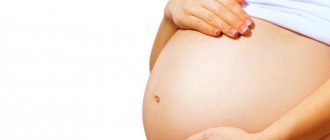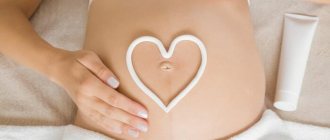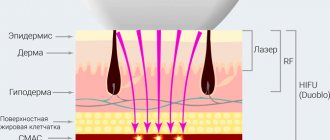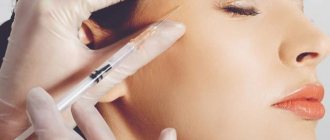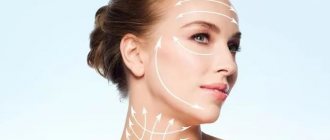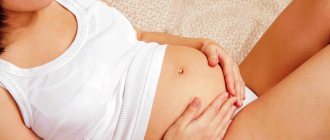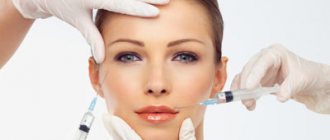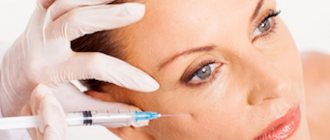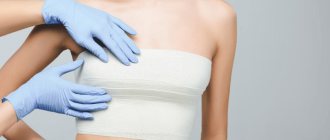I don’t know exactly what my “causally significant allergens” are. What should I do?
During pregnancy, any provocative tests are contraindicated, including allergy skin tests and patch tests, in order to avoid a very unlikely, but theoretically possible anaphylactic reaction to the introduction of an allergen, and also due to the possible distortion of the results due to an altered state of the immune system. systems of a pregnant woman. Therefore, in addition to the main method - questioning and physical examination - diagnostic procedures are limited to laboratory methods, in particular the determination of allergen-specific IgE.
Prevention of soreness
To relieve chest pain, it is recommended:
- Wear a cotton bra with wide straps that exactly matches your breast size.
- Do rubdowns every day or take a contrast shower, take air baths, take walks.
- Wash your skin twice a day with warm water without soap.
- Treat your breasts with anti-stretch mark creams. They saturate the skin with nutrients and give it elasticity.
- If cracks appear on the nipples, use ointments that contain vitamin B.
- Regularly perform exercises that strengthen the muscular system and improve blood circulation.
It is impossible to find out the cause of the pain on your own. Therefore, if you experience any discomfort in the abdominal area, you should consult a gynecologist to avoid dangerous complications.
Take care of your health and contact a qualified physician if you experience any symptoms.
It’s clear that you can even take hormones if it’s unbearable. What about antihistamines and antileukotriene drugs?
So, if “the benefit to the mother outweighs the potential risk to the fetus,” then all antihistamines are possible, except clemastine, desloratadine and levocetirizine. No harm has been observed from these drugs, their use is not recommended, since “the safety profile has not been studied.”
It is worth abstaining or limiting the use of all antihistamines in the last month of pregnancy, as there may be a decrease in eating behavior, the development of transient neurological symptoms and diarrhea in newborns. It is not recommended to take the antihistamine with a pronounced anxiolytic effect, hydroxyzine. Its use in the late third trimester and immediately before birth in a number of cases caused transient hypotension, extrapyramidal disorders, depression of the central nervous system and respiration in newborns, and animal experiments described fetal malformations and an increase in the frequency of spontaneous abortions when taking doses of the drug significantly higher than human doses.
The use of antileukotriene drugs is allowed with caution, but it is worth knowing that in experiments in animals, montelukast penetrated the placenta.
Discharge from the nipple. What's happened? - video
is not responsible for the accuracy of the information presented in this video clip.
Source - Dr. Levchenko Sources:
- POSSIBLE CAUSES OF SEROUS DISCHARGE FROM THE NIPPLES OF THE MAMMARY GLANDS. Hanafiev G.Kh., Berzin S.A., Maltseva U.Yu., Mazur A.E. // Tumors of the female reproductive system. – 2012. – No. 1. – P. 17-19.
- IMMUNOLOGICAL FEATURES OF SENSING BREAST GLANDS. Hanafiev G.Kh., Berzin S.A. // Tumors of the female reproductive system. – 2014. – No. 4. – P. 46-50.
- CONDITION OF BREAST TISSUE AND RISK OF BREAST CANCER DEVELOPMENT IN PATHOLOGICAL SECERNATION SYNDROME. Hanafiev G.Kh. // Tumors of the female reproductive system. – 2014. – No. 3. – P. 47-53.
- Hormonal composition of the secretion of secerating mammary glands. Hanafiev G.Kh., Berzin S.A., Maltseva U.Yu. // Collection of scientific papers “Current issues in obstetrics and gynecology”. - Kirov. - 2008.
- Outcomes of pregnancy and childbirth with fetoplacental insufficiency of varying severity. Afanasyeva N.V., Strizhakov A.N. // 2004.- 3(2). pp. 7–13.
- Cystic disease of the mammary glands. Hanafiev G.Kh., Berzin S.A., Demidov S.M., Bushueva T.V. // Monograph. - Ekaterinburg. - 2002.
How dangerous are decongestants for the fetus?
There is some danger. Topical and oral forms of decongestants should be avoided: oxymetazoline and combination products containing phenylephrine and pseudoephedrine. Oxymetazoline was included in the list because of the only case of placental insufficiency described in 1985, which occurred after taking doses four times higher than therapeutic, and also because of the theoretical possibility of its vasoconstrictor effect on the placental vessels. Other studies including 167 women found no changes.
The use of phenylephrine and pseudoephedrine may have been associated with cases of development of defects of the abdominal wall, face, and intestines (animal experiments and several case-control studies). One study also showed an increased incidence of malformations in women who smoked and used these drugs. In a number of other studies, which included more than 4,000 women, the data were not confirmed.
If a patient uses any of the above during pregnancy, it’s not a big deal. The described troubles are known from individual clinical cases.
Completion of GW
In general, recommendations in this period will not differ much from previous ones. Comfortable and well-supportive underwear, care with creams and oils, a contrast shower, but without a large temperature difference are also recommended.
During the period of completion of lactation, you can focus on exercises for the chest muscles, this will help maintain the shape of the breasts and its tone. The shape of the breast is usually restored a year after completion of breastfeeding .
You can read more about completing breastfeeding and breast care during this period in our article “Completing breastfeeding.”
Yulia Rusinova, specialist in breastfeeding and baby nutrition
Literature: 1. “Breastfeeding” - Martha Sears, William Sears 2. “Primary Health” - Michelle Oden 3. “Ecology of Infancy. First year” – L.V. Trunov, L.M. Kitaev 4. AKEV materials 5. La Leche Legue materials 6. WHO/UNICEF course “Breastfeeding Counseling”, 2006 7. “The Art of Breastfeeding” - Natalie Wilson, La Leche Legue 8. “Your baby from birth to 2 years" - Martha Sears, William Sears
What if I don’t drink, smoke, eat milk, eggs, chocolate, nuts, etc.?
Maternal smoking increases the risk of asthma, allergic rhinitis and allergic dermatoses in the child; drinking alcohol, among other health problems, also increases the likelihood of the child developing atopic dermatitis.
But giving up milk, eggs, nuts, seafood and other gastronomic pleasures of life, as well as taking probiotics, does not reduce the risk of a child’s sensitization to food allergens. According to individual studies, maternal dietary liberties during pregnancy and lactation, on the contrary, can contribute to the development of immunological tolerance, but this issue has not yet been sufficiently studied. In any case, you shouldn’t limit yourself to healthy food.
Discharge from the nipples during pregnancy and breastfeeding
Typically, the appearance of colostrum begins in the second trimester of pregnancy, but sometimes the first yellowish or white droplets on the nipples may appear earlier. This is completely normal. If a pregnant woman experiences white or pink discharge and her nipples hurt, this is a reason to consult a doctor.
What to do if discharge from the mammary glands appears during pregnancy?
It must be borne in mind that normally, after the end of the lactation period, a woman may still experience discharge from the breast for some period. In medicine, a period of 4-5 months is often mentioned, which is “given” for the complete completion of feeding. Therefore, if, after 5 months after the end of breastfeeding, a woman still observes any discharge from the nipples, then she should definitely make an appointment with a doctor to exclude the occurrence of diseases or hormonal imbalances.
That is, it is impossible to prevent the development of allergies in a child?
You can reduce the likelihood of its development. As stated above, do not be exposed to tobacco smoke or drink alcohol.
Information on other methods of preventing allergies is very contradictory. It is possible that ASIT during pregnancy reduces the risk of developing allergies in a child, but these data are represented by single studies in which statistical significance was not achieved. Some studies have shown that having a dog in the house reduces the risk of developing bronchial asthma and allergic dermatoses in children born into families without a hereditary predisposition to allergies; However, according to other data, the presence of a dog increases the risk of breathing difficulties in newborns, while the presence of a cat reduces it. While nothing can be said with certainty, theoretically both approaches can be easily justified, however, at present, allergological organizations around the world do not recommend that people suffering from allergic diseases keep animals in the house.
Sources
- Evidence-based allergology-immunology - Kolkhir P.V. - Practical guide. — M.: Practical medicine. — 2010 — 528 p.
- Pali-Schöll I., Namazy J., Jensen-Jarolim E. Allergic diseases and asthma in pregnancy, a secondary publication. World Allergy Organization Journal. 2017; 10:10.
- Lieberman J. Should we encourage allergen immunotherapy during pregnancy? Expert Rev Clin Immunol. 2014; 10 (3): 317–9.
- Murphy VE, Zakar T, Smith R, Giles WB, Gibson PG, et al. Reduced 11beta-Hydroxysteroid Dehydrogenase Type 2 Activity Is Associated With Decreased Birth Weight Centile in Pregnancies Complicated by Asthma. J Clin Endocrinol Metab. 2002; 87(4):1660–1668.
- Lunghi L., Pavan B., Biondi C., Paolillo R., Valerio A., et al. Use of glucocorticoids in pregnancy. Curr Pharm Des. 2010; 16 (32): 3616–37.
- Barker DJ, Eriksson JG, Forsén T., Osmond C. Fetal origins of adult disease: strength of effects and biological basis. Int J Epidemiol. 2002; 31(6):1235–9.
What should you pay attention to?
Any processes other than physiological certainly require attention. When faced with a pathology, you cannot wait until it progresses, but consult a doctor in time. And even cosmetic problems can have clear internal reasons, which also require the participation of a specialist.
Skin changes
Skin changes are the first thing people pay attention to during examination. The following can be determined visually:
- Change in color (redness, pallor).
- Rashes (spots, papules, pustules, blisters).
- Erosions and ulcerative defects.
- Peeling, crusts, etc.
When the skin of the breast is rough and dry, this will be clearly determined by palpation, as well as whether there is a thickening or elevation in a certain area. The consistency of space-occupying formations, their localization, boundaries and sizes, mobility and adhesion to the skin, local temperature and pain - all this is also determined by palpation. Signs of a malignant process include:
- Breast deformation.
- Wrinkled and retracted skin (“lemon peel”).
- Knot of rocky density.
- Swelling of the entire gland.
If such changes affect one breast, progress gradually and are not accompanied by pain (in the early stages), then there is every reason to suspect breast cancer.
Papilla and areola
In situations where the nipples itch and peel, pay attention to their appearance (shape, color), the presence of plaque or other defects, while simultaneously examining the areola. You should find out what sensations a woman experiences in the areas being examined (burning, pain, pulsation) and what causes their development.
By palpating the nipples, they determine whether there is discharge from them and what their nature is (serous, bloody, purulent). During lactation and in the last stages of pregnancy, it is useful to find out whether breast milk is secreted well.
Additional symptoms
In addition to local signs, determined visually and by touch in the area of the problem gland, other symptoms are also important for the diagnostician. At the appointment, the doctor finds out whether your general health is disturbed (fever, malaise, lack of appetite), determines the size of the lymph nodes in the armpits, examines the second breast and pays attention to the skin as a whole (rashes, color, dryness). Every nuance can be important for making a diagnosis.
The doctor will be able to give an affirmative answer regarding the cause of dryness and flaking only after a comprehensive diagnosis.
How to get rid of it?
It will not be news that in order to eliminate dryness it is necessary to influence the cause of its occurrence. In the most common situations, breast skin requires proper care. It is worth giving up aggressive detergents and drying lotions, replacing them with delicate cleansing, softening and moisturizing products (foam, milk, creams). Homemade breast masks made from available ingredients will also help with care:
- Oatmeal, milk, honey, butter.
- Banana pulp with olive oil.
- Crushed oatmeal with grated carrots.
At the same time, it is necessary to normalize the drinking regime and the intake of vitamins from food. During breastfeeding, it is recommended to treat nipples with ointments based on medical lanolin and dexpanthenol. This helps eliminate dryness and faster healing of damage. Lotions made from decoctions of chamomile, string, lemon balm, as well as lubricating the skin with almond oil will help relieve itching during pregnancy.
By removing the allergen (underwear, cosmetics), you can eliminate the skin reaction itself, which is the effectiveness of elimination therapy. If the disease has acquired the character of neurodermatitis, then the use of antihistamines and corticosteroids will be required.
The only situation where radical correction is necessary is breast cancer. Unfortunately, in other cases the prognosis becomes disappointing. Surgical removal of the tumor is combined with radiation, hormone and chemotherapy. There are also biological drugs that act on certain receptors on cancer cells.
Preventive measures
Negative changes in the skin of the breast can be prevented only by following a number of rules. Preventive recommendations include the following:
- Responsible choice of underwear and cosmetics.
- Proper feeding of the child.
- Adequate skin care.
- Complete nutrition.
- Rejection of bad habits.
- Self-breast examination.
- Passing medical examinations.
- Timely consultation with a doctor.
These are clear and simple conditions, compliance with which will minimize the risk of deterioration of the breast skin condition. Even dangerous conditions can be prevented if you have sufficient awareness and take a responsible attitude towards your own health.
By following your doctor’s recommendations, you will not only be able to eliminate the source of the unpleasant symptoms, but also prevent the problem from occurring in the future.
The situation of dryness and peeling that occurs on the skin of the breast and nipple area is familiar to many women. It can be caused by various conditions, and it is not always associated with physiological processes. Therefore, it is always better to play it safe and seek help from a specialist.

